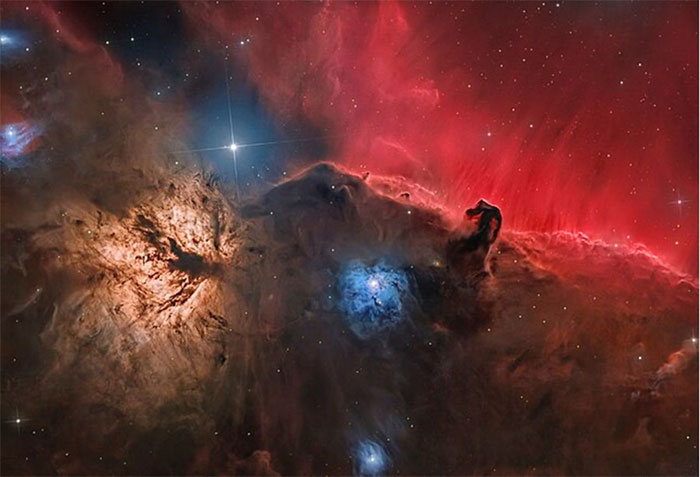Williamina Fleming - From maid to famous astronomer
From a maid, Williamina Fleming became a famous astronomer, inspiring generations of women in the field of science.
Williamina Fleming's work at the Harvard College Observatory laid the foundation for stellar classification systems and led to the discovery of many celestial objects. In particular, her determination and talent, from maid to famous astronomer, inspired generations of women in the field of science.
Unexpected turn
Williamina Paton Stevens Fleming was born on May 15, 1857 in Dundee, Scotland, into a family of six children. Her mother, Mary Walker, was a housewife, while her father, Robert Stevens, was an engraver and goldsmith.

The Horsehead Nebula - Williamina Fleming's important discovery.
A bright girl, Fleming became a trainee teacher at a local school at the age of 14. At the age of 20, she made one of the biggest mistakes of her life by marrying James Orr Fleming, a widowed accountant.
With this man she had a son, Edward P. Fleming. A year after their marriage, the couple left Scotland and moved to the United States, settling in Boston, Massachusetts. Less than a year later, James abandoned his wife and child, leaving Fleming, now 21, to support herself and her young son.
Fleming first worked as a maid in the home of Edward Charles Pickering , the director of the Harvard College Observatory (HCO). Pickering's wife quickly realized that there was something special about this young maid and suggested that her husband find Fleming a more suitable job. Pickering helped her work part-time at his observatory. This was in 1879.
It was not glamorous work, but Fleming worked hard and her intelligence shone through. In 1881, Pickering asked his former maid to join the HCO in an official capacity. He taught her how to analyze stellar spectra and asked her to join his newly formed Harvard Computers.
This was an all-female group of calculators, performing complex equations, before the advent of electronic computers. They were tasked with performing difficult calculations and editing the observatory's publications. At this point, Fleming officially entered the door of science.
Path to science
Fleming's next break came in 1886, when the wealthy widow of astronomer Henry Draper, Mary Anna Draper , established the Henry Draper Memorial Fund and funded HCO research. This event led Pickering to launch the Henry Draper Catalog, an ambitious project to collect spectra of as many stars as possible and then index and classify them.

Williamina Fleming (1857 - 1911).
With diligence and a keen eye, she excelled in this role, being put in charge of the entire project and becoming the supervisor of the observatory's female assistants, often referred to as ' Pickering's Harem'. Under her leadership, the team made significant strides in classifying stars, identifying variable stars and nebulae.
When the first catalogue was published in 1890, it contained 10,000 stars that Fleming's team had catalogued. Most of them were created by her. Eight years later, she was appointed Curator of Astronomical Photographs, a position that had never been held by a woman before. Fleming made many important discoveries. In addition to her catalogue of more than 10,000 stars, she also discovered a total of 59 gas nebulae, more than 310 variable stars, and 10 new stars.
Her most famous discovery , however, came in 1888, when she identified the Horsehead Nebula in the constellation Orion on a telescopic plate taken by Pickering's brother.
Sadly, Fleming's name was omitted from the first Draper Index Catalogue, and Pickering received all the credit. However, by the time the second catalogue was published in 1908, Fleming and her team were well-known enough to be included.
Fleming is also credited with discovering the first white dwarf, 40 Eridani B, in 1910. This discovery was groundbreaking, as white dwarfs are an important stage in the life cycle of stars and provide valuable insights into their evolution.
From humble beginnings as a domestic servant to her important work as an astronomer, Fleming overcame social and personal obstacles to make lasting contributions to the field of astronomy.
Her work in stellar classification, discovery of celestial bodies, and leadership at the Harvard Observatory have significantly advanced our understanding of the universe.
Williamina Fleming became a US citizen in 1907 and continued her astronomical research until her death from pneumonia on May 21, 1911. Throughout her career, she received many honors from the American, British, French, and other astronomical societies. In a world that was still heavily male-dominated, Williamina Fleming overcame many obstacles and achieved many successes in the field of science. She was not only a shining example for researchers but also for the entire scientific community.
- Williamina Fleming - from a maid to a world-famous astronomer
- The 10 most famous physicists and astronomers of all time
- The famous Vietnamese astronomers in the world
- Announcing the truth about the first patient using penicillin
- The discovery of the remains resembles the astronomer Copernicus
- The Pope honors astronomer Galileo
- 80 years ago, Alexander Fleming warned humanity about the dark day
- The most famous Nobel prizes in history
- There will be robots adapting to situations and people
- The palace maid had to stay hydrated when the maid Cixi went to the bathroom: When everyone knew the reason, everyone was bored!
- Home maid robots can be hacked to attack homeowners
- Famous Snake scientists
 The most famous scientific failures in history
The most famous scientific failures in history Mysterious genius mechanic and the machine froze time
Mysterious genius mechanic and the machine froze time The son carries the 'bad gene' of genius Albert Einstein
The son carries the 'bad gene' of genius Albert Einstein Isaac Newton
Isaac Newton